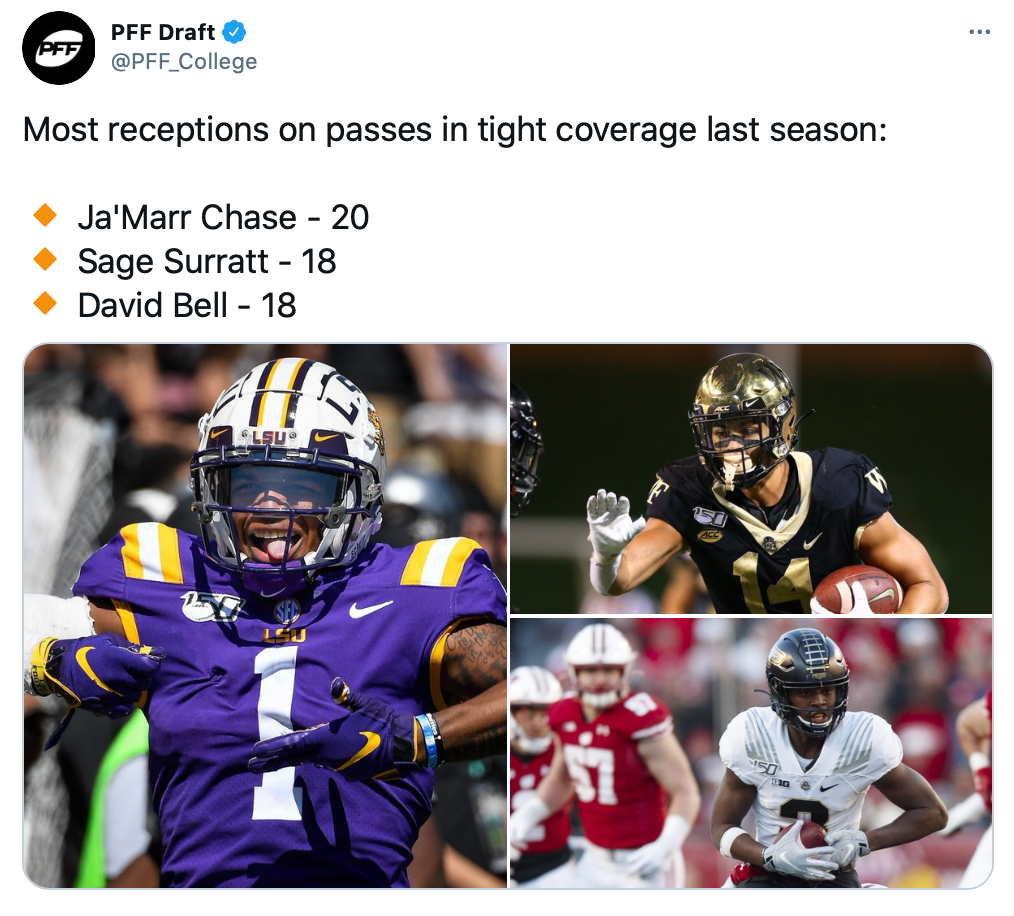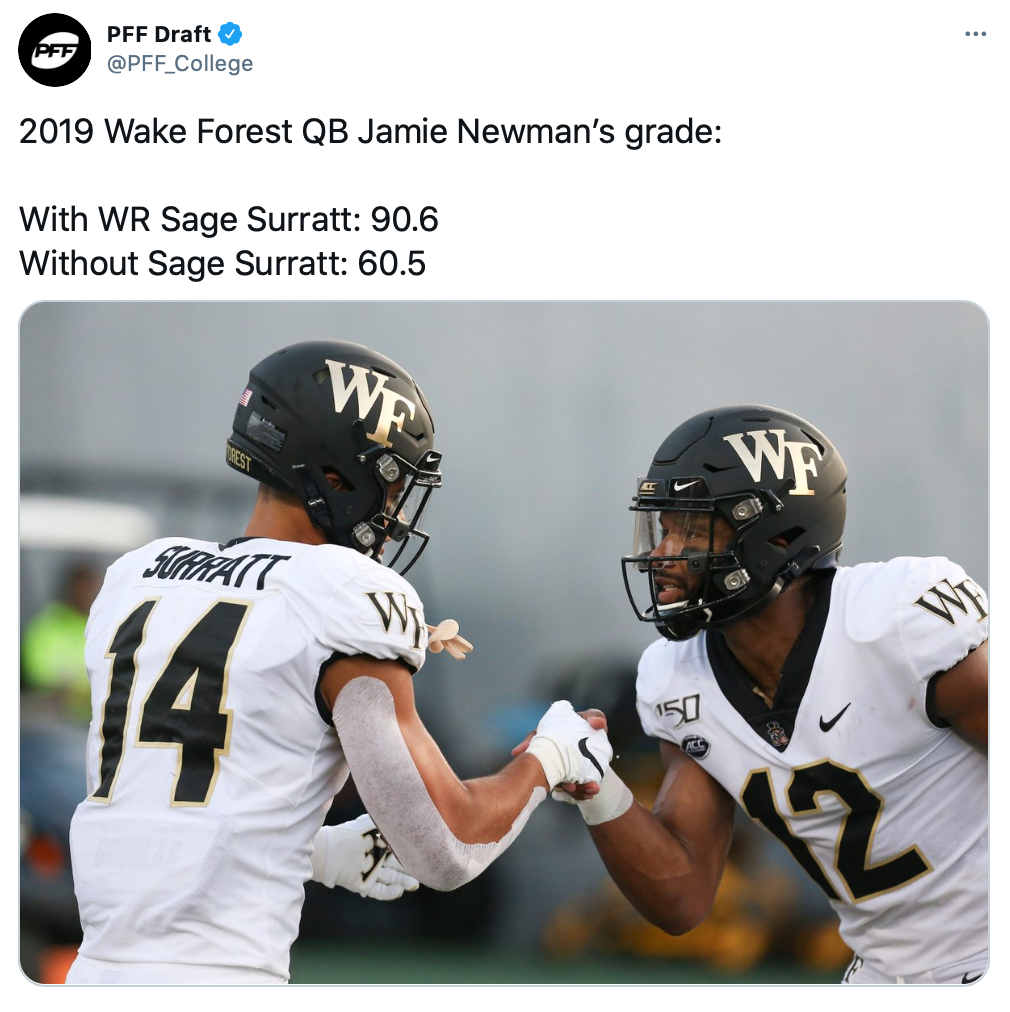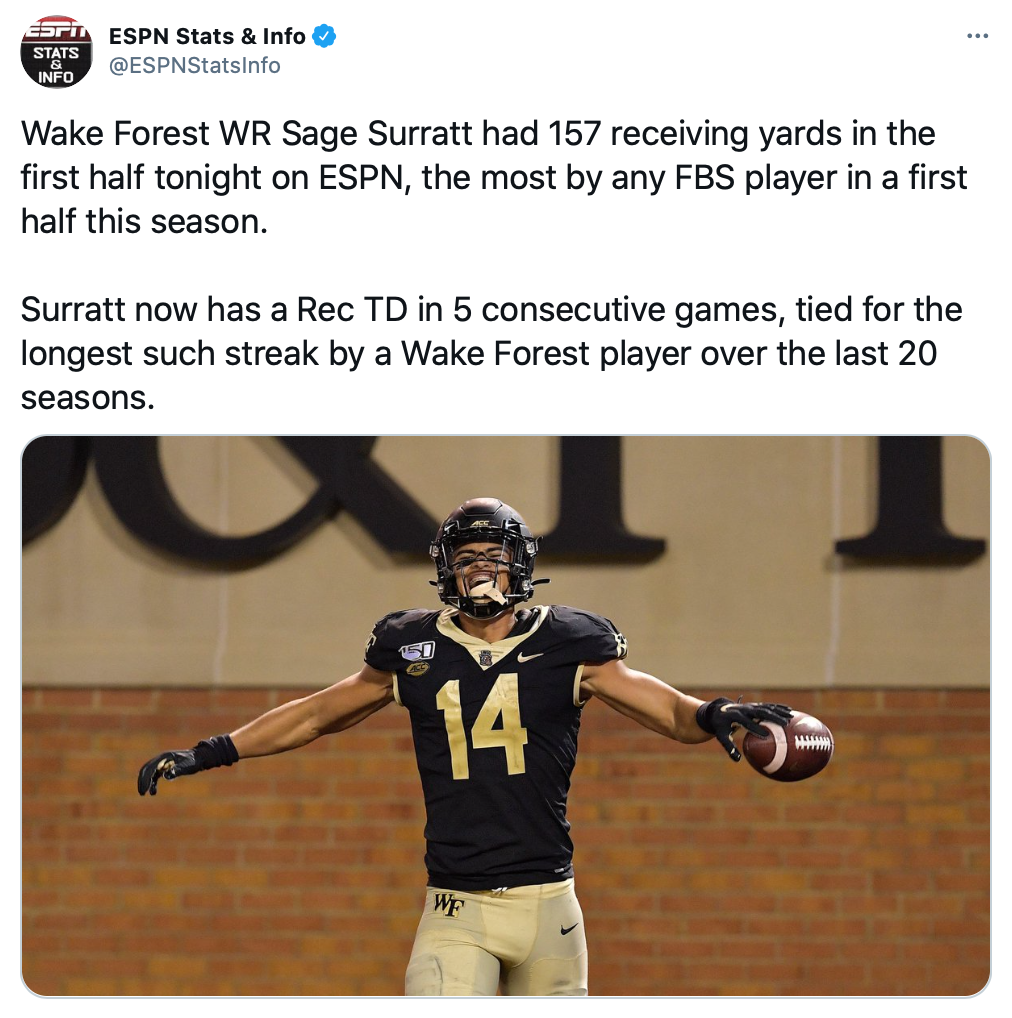Sage Surratt
WR | Wake Forest Demon Deacons | 6-2 | 215 lbs.
Rookie Expectations
Over the last three NFL seasons, wide receivers who predominantly lined up on the outside have run five particular routes for about 75% of total routes: Gos, Hitches, Outs, Slants, and Crossers. For WRs playing from the slot, these five routes are also featured, at slightly altered percentages, for a nearly identical combined total. The final 25% will be distributed between Ins, Posts, Corners, some Screens, and the rest on exotic combo routes when split wide. For slot WRs, the majority of that 25% will go toward Screens and shallow work in the flat. Whenever I make references to “NFL routes” in these Dyno rookie profiles, those are the guidelines I am following.
The Story
Digging into the background on Sage Surratt reveals so much more than your typical football player. To get us started, Surratt was named the North Carolina player of the year in both football and basketball his senior season at Lincolnton High School. He put up sensational numbers including 35.7 points per game on the basketball court to end his career as Lincoln County’s all-time leading scorer. On the football field, he caught 129 passes for 2,104 receiving yards and 28 TDs. He also added 120 solo tackles as an outside LB, with 10 QB sacks, returned two of his four INTs for TDs, and added five batted passes.
As if that were not enough, Surratt earned the distinction as the valedictorian of his class with a 5.09 GPA. Prior to that phenomenal senior year, Sage had already accepted a full scholarship to play football for Harvard University. But Surratt decommitted from the Crimson in order to play in a Power Five conference, and closer to home. The lateral decision to transfer from East Lincoln (ranked at 1,472 nationally his junior season) to Lincolnton (1,585) rather than transferring to a prestigious prep school may have resulted in the lukewarm interest he received from colleges. It could also have been due to his decision to remain close to home. Surratt didn’t receive a single FBS scholarship offer from outside of the Carolinas.
Surratt may not have received a litany of offers, but he managed to turn himself into a serious NFL prospect in only 22 games for the Demon Deacons. After taking a redshirt his first year in Winston-Salem, Surratt started nine-of-13 games in 2018. He exploded in 2019 with over 1,000 receiving yards and 11 TDs in nine games. Unfortunately, his season was cut short with a right shoulder injury that required surgery. Surratt made the decision to return for his redshirt junior campaign before ultimately opting out of the season, both due to COVID-19 and to focus on training for the NFL Draft.
The Attributes
It sure does seem that Surratt is able to do almost anything he applies his mind and body toward. Check out this video for an entertaining assessment of how far that logic applies. Sage’s older brother, Chazz Surratt, joined the UNC Tar Heels in 2016 as a QB, but switched to LB prior to his junior season. We will hear both Surratt brothers’ names called during the 2021 Draft as Chazz turned heads following his position switch. Starting our film review of Sage during his junior season at East Lincoln, it doesn’t take much viewing time to see the massive talent disparity. It would be a mistake to overlook what we have on film simply due to the level of competition. But far too many plays have Surratt one-cutting his way through all three levels of the defense before churning toward the end zone.
At 0:57 in the video, we see Surratt showcasing an impressive vertical on a 50-50 throw facing double coverage with both defenders egregiously out of position. We have a multitude of further examples presenting his high-pointing ability (2:11, 3:58, 4:26, 4:43, 7:45, 7:56, 8:28, 8:46, 9:54, 11:14, and 13:57). On the following play (1:02), we get our first glimpse of Sage reaching into his top-end speed. Since Surratt never tested athletically at a Nike Opening, we have no measurements for reference. The out routes at 6:15, 8:19, 9:13, 12:59, 13:36, and 14:36 are of note since, as we’ll see in his Wake Forest tape later, he failed to show much on that particular NFL route in college. The huge amount of production on designed screens will not translate to the NFL game.
We can take several things away from his junior high-school tape. He’s a big bodied, sure-handed receiver with plus ability to high-point the ball, and work over the middle of the field. We see Surratt doing plenty of work on Go’s, Hitches, and Slants, and he actually gave us some examples on Outs. He’s a load to bring down, utilizes jump-cuts to make defenders pay for their overpursuit. He keeps his eyes locked downfield, always chaining moves together — particularly a strong stiff-arm — to maximize gains.
Let’s take a look at his senior tape, after transferring to Lincolnton, to see how his game/body has developed. On the very first play, it’s apparent Sage is playing faster. He’s added bulk to his frame, with the appearance of RB thickness. We could learn so much more from this film were he facing top competition. There’s no need to add to the long list of Surratt high-pointing the ball; suffice it to say he’s still doing his thing.
But here’s something to point out for latter purposes: take a look at consecutive plays in goal-to-go (G2G) situations at 1:39, 1:47, 1:58, and 2:05 to see Surratt using those hops on End Zone Fades, Quick Outs, 50-50 balls, etc. He leaves nothing to chance plucking the ball from the air with excellent sideline awareness. We’ll see more of the same in his Wake Forest film.
We can take note of Surratt’s ability to fight through contact to complete the catch. His overmatched secondary competition has no other choice but to hold on for dear life in man coverage at 2:42. In a Cover 1, the CB is playing it dangerous allowing Sage to the outside, and paying the price. He’s perfectly comfortable collecting the ball over his shoulder deep, with 3:58 as a perfect example. The QB that ends up playing with Surratt will fall in love with how fluidly he adjusts his body to protect the ball on inaccurate throws. At this point, we have a solid starter profile on Surratt. Since his father was an assistant coach for the Wolves, Sage’s decision to play his senior season at Lincolnton is perfectly understandable. But it’s plainly clear he had already outplayed the competition during his junior year.
The jump to the ACC is a welcomed sight in the assessment of Surratt’s redshirt freshman film. However, with under 750 career routes run for the Demon Deacons in which to evaluate him, the fact that a third of those career reps came while facing Group of Five or FCS competition is quite disappointing. The video opens with highlights facing Towson University. Skipping ahead to the 0:23 mark, we see Boston College CB Hamp Cheevers all over this quick hitch. But Surratt does a great job locating the ball, then strings together a stiff-arm and jump cut to force two missed tackles. As alluded to above, the next play at 0:46 showcases Surratt’s G2G fire on a slant defended in man by Cheevers.
I absolutely love the example at 1:46 with Florida State in Cover 1 and Surratt facing star CB Asante Samuel Jr. (yes, you are old). In Samuel, we have NFL talent in defense of Sage on an NFL route (2R/Slant). And Surratt not only completes the catch, but he shows us that he’s still a load to bring down in the Power Five. On a switch route at 1:55 with Stanford Samuels III in man (Cover 0), Surratt has zero issues in the rain separating after the rub. At 3:07 in the video, we have Jamie Newman under center facing a five-man Cover 1, CB blitz where the Will LB adds himself to the pass rush when the RB he’s responsible for stays in to pass protect. Surratt immediately spots the call, sitting down on a hot read hitch with the safety dropping down in coverage. Surratt makes quick work of the arm-tackle attempt for a big gain. On the next clip (3:29), Surratt outmuscles Teshaun Smith on the contested slant.
An issue I feel is due to OC Warren Ruggiero’s system, Surratt was only asked to run Outs on just under 10% of career routes. Sage did show us his ability on Outs in high school, and we see more at the 3:42 and 4:19 mark. It’s nothing exciting, but it’ll be the third-most likely route Sage will be asked to run as an NFL rookie. But rookies will be required to run no other route more than 9s (Gos), for which we have an outstanding over-the-shoulder, and one-handed reception contested by NC State CB Chris Ingram at 4:01.
Mastering the hitch route is key toward becoming a PPR stud. They won’t be showcased on SportsCenter, but help fill in the gaps between the sexier plays to lift those FPG averages. We have consecutive examples facing NC State at 4:28 and 4:40. As the boundary WR opposite trips at 4:48, Surratt is isolated in Cover 2-Man on a Back Shoulder Go. The key to this route is not as much the downfield separation as the WRs body control, and technique. Sage puts both on full display. I love the play at the 5:37 mark, facing future NFL CB Josh Blackwell of Duke in man. Blackwell attempts to jam Surratt at the line of scrimmage, as Sage forces him onto skates before boxing him out on the hitch for the first-down conversion.
At 1:30 in the video, we see the only TD Surratt scored outside of a G2G situation during his redshirt freshman season, though it looks similar. Sage abuses former Duke CB Antone Williams in man on the 9S/End Zone Fade. We are then shown several views highlighting his concentration to complete the catch. Nothing from his 2018 film diminishes the impression he made on his HS tape. Rather, Surratt solidified my belief that the phenomenal traits shown on his HS tape were not the result of facing watered-down competition. However, the 380 routes comprising his redshirt sophomore tape will close the final curtain on our Sage Surratt Dyno study.
He managed to eclipse 1,000 receiving yards in only nine games, continuing to circle his strong connection established with Jamie Newman. Surratt proves from the very first highlight that he’s far from done filling out his frame. Since we have Utah State CB DJ Williams in coverage the majority of the game, we’ll skip past Week 1.
Surratt continues to show us how comfortable he is working over the middle of the field facing his brother’s North Carolina team at 1:19. We see a perfect example of his strong hands at 1:36, plucking the ball from the air deep facing man.
Surratt’s yardage per route (YPRR) efficiency improved by 40% over his redshirt freshman season. And the area of his game that improved the most is facing man coverage, nearly doubling his YPRR. On only 26% of routes facing man, Surratt generated 45% of TDs, and an extraordinary 2.96 YPRR. We have a multitude of examples of where these improvements come in, including the run-pass option (RPO) at 1:48, then others at 2:50, 4:27, 4:39, 4:48, 6:02.
Surratt would score 36% of his 2019 TDs on only 31 total routes with the Demon Deacons in G2G situations. We have all examples — sans the TD against Rice — beginning at 3:12, a one-hander at 4:03, and finally at 5:23. The TD grab at 5:01 is just outside of the G2G definition, but serves to highlight his intimidating red zone prowess, nonetheless.
The tape also circles production from Surratt from the slot opposed by Cover 6 at 3:26 against Elon of the FCS. A better example is found at 10:03, facing Virginia Tech. While I do not envision Surratt as an NFL slot, the ability to see snaps inside if need be will add value. Facing Louisville’s Cover 4 opposite trips, CB Anthony Johnson is helpless in man defense of Surratt on another hitch. One of the few examples of Surratt facing Cover 3 can be found on the very next clip (6:44). Most WRs fresh out of college are forced to play catchup facing Cover 3 since it’s rarely utilized in the college game. But they will face the three-deep scheme on around a third of routes in the NFL. Surratt’s plus ability to sit down on hitches within zone holes will lessen that learning curve.
Once again facing off with FSU CB Stanford Samuels III, Surratt would gain nearly 100 of his 170 receiving yards opposed by the former four-star prospect. All four of his receptions for 99 yards against Samuels are shown consecutively, beginning at 7:02. To definitively drive home the point on Surratt’s physicality, focus your eyes on the play at 9:13. It takes no less than six NC State defenders to bring him to the ground. Finally, we come to the game in which Surratt ultimately injures his shoulder facing Virginia Tech. The crosser at 9:44 stands as a true anomaly since he would run the pattern on less than 5% of career routes.
Fantasy Fit
With his strong upper body and low center-of-gravity, the player comps begin and end with former Dallas Cowboys’ WR Miles Austin. Austin wasn’t able to fulfill the extent of the immense promise he displayed in the 2009-10 seasons due to a string of injuries that cut his career short after 10 seasons. But Austin’s size-adjusted speed, ability after-the-catch, and command of the underneath and third-level production typifies my expectations for Surratt. Since Wake Forest played from 11 personnel on nearly 100% of snaps during his two college seasons, we could view him from that box. Within that personnel “requirement,” the landing spots that stand out the most are Washington and Cincinnati.
WFT OC Scott Turner is desperate for production at WR opposite superstar Terry McLaurin. They’ll most likely be hoping one of the “big four” athletic QBs drops to them at 1.19, possibly even considering Alabama’s Mac Jones. They could also find themselves on the edge of their seats hoping Surratt lasts until they pick in the second round. For the Bengals, the undeniable issues at O-line that led to the horrific knee injury to Joe Burrow must be addressed. And we may even see them double-dip at O-line the first two rounds. If Surratt does fall to the third, he will not last long if Cincy allows him to slip past them at 3.05. They have a talented group of WRs but, if they aren’t sold on Auden Tate as the replacement for A.J. Green, Surratt would be a masterful addition.
All of that said, I have little doubt Surratt could adjust to an offense fielding a higher percentage of heavy personnel. Other teams that catch my eye are Philadelphia, San Francisco, New England, and, most of all, the Los Angeles Chargers. It remains to be seen if the LAC front office and new OC Joe Lombardi are willing to keep Mike Williams at his $15.68 million 2021 salary. If they attempt to move on from him this year or next, Surratt could be a target to replace him.
The Bottom Line
We are forced to evaluate Surratt at this stage without any official athletic measurements. His testing results from Wake Forest’s Pro Day will fill in those blanks for us. From his film, I estimate that he’ll run the 40 in the 4.4s. That would be more than enough to give him a 2nd-or-3rd round grade. He’s bigger, more physical than Ja’Marr Chase, and, like Chase, is someone I view as settling in as a Split End (X) since the analytics show he’s struggled in motion.
He’s not the lid-lifting firework waiting to happen like Chase, but Sage has provided a ton of evidence in support of his proficiency on four-of-five most important NFL routes. With his arsenal of weapons, we can expect Surratt to dig in for a long, productive NFL career. At this stage in the evaluation process, I have Surratt listed as the WR8 on my Dyno Big Board for 2021 rookie drafts.











